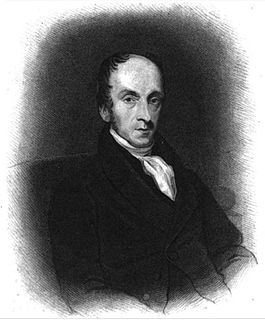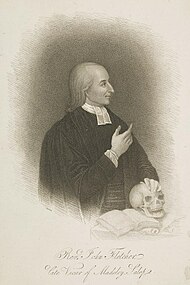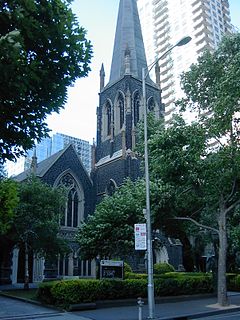Related Research Articles

Methodism, also called the Methodist movement, is a group of historically related denominations of Protestant Christianity which derive their doctrine of practice and belief from the life and teachings of John Wesley. George Whitefield and John's brother Charles Wesley were also significant early leaders in the movement. It originated as a revival movement within the 18th-century Church of England and became a separate denomination after Wesley's death. The movement spread throughout the British Empire, the United States, and beyond because of vigorous missionary work, today claiming approximately 80 million adherents worldwide.

John Wesley was an English cleric, theologian and evangelist who was a leader of a revival movement within the Church of England known as Methodism. The societies he founded became the dominant form of the independent Methodist movement that continues to this day.

Primitive Methodism was a major movement in English Methodism from about 1810 until the Methodist Union in 1932. The denomination emerged from a revival at Mow Cop in Staffordshire. Primitive meant "simple" or "relating to an original stage"; the Primitive Methodists saw themselves as practising a purer form of Christianity, closer to the earliest Methodists.

Richard Watson (1781–1833) was a British Methodist theologian who was one of the most important figures in 19th century Methodism.
The Methodist Church of Great Britain is a Protestant Christian denomination in Britain and the mother church to Methodists worldwide. It participates in the World Methodist Council, the World Council of Churches and other ecumenical associations.

John William Fletcher, English divine, was born at Nyon in Switzerland. Of French Huguenot stock, his given name was actually Jean Guillaume de la Fléchère. Fletcher was a contemporary of John Wesley, a key interpreter of Wesleyan theology in the 18th century, and one of Methodism's first great theologians. Fletcher was renowned in Britain for his piety and generosity; when asked if he had any needs, he responded, "...I want nothing but more grace."

Hugh Bourne along with William Clowes was the joint founder of Primitive Methodism, the largest offshoot of Wesleyan Methodism and, in the mid nineteenth century, an influential Protestant Christian movement in its own right.

Jabez Bunting was an English Methodist leader and the most prominent Methodist after John Wesley's death in 1791.

Wesley Church is a Uniting Church in the centre of Melbourne, in the State of Victoria, Australia.

Wesley Methodist Church is the oldest Methodist church in Singapore. It is the second Methodist Church to be built in Singapore after the Methodist Episcopal Church at Coleman Street which subsequently became a school hall. It is located in Fort Canning Hill.

William Fitzjames Oldham was an Indian-born British-American Bishop of the Methodist Episcopal Church and Missionary Bishop for Southern Asia. He distinguished himself as a missionary, an author and a church official. He was the founder of Anglo Chinese School in Singapore in 1886.

Rev. Frederick James Jobson D.D. - commonly styled F. J. Jobson - painter, architect and Wesleyan Methodist minister, became President of the Methodist Conference in 1869, and Treasurer of the Wesleyan Methodist Foreign Mission Society, 1869–1882. Alongside his important role in encouraging Methodist architecture, he was the author of devotional, architectural, biographical and travel books - which, combined with his role superintending the Wesleyan Methodist Magazine for over a decade and related duties - led to a great expansion of Methodist publishing. His topographical paintings provide a further legacy.

Governance of the Methodist Church of Great Britain is based on the principle of connexionalism—a highly centralised structure. From its inception under John Wesley, Methodism has always laid strong emphasis on the interdependence and mutual support, in terms of ministry, mission and finance, of one local congregation for another. The Church community has never been seen in isolation either from its immediately neighbouring Church communities or from the centralised national organisation. Wesley himself journeyed around the country, preaching, evangelizing and establishing local worshipping communities, often under lay leadership. Soon these local communities of worshipping Christians formalised their relationships with neighbouring Methodist communities to create Circuits, and the Circuits and Churches contained within them, were from the very beginning 'connected' to the centre and Methodism's governing body, the annual Conference.

Victoria Hall is a Methodist place of worship situated on Norfolk Street in Sheffield city centre. It is the most important Methodist building in Sheffield and it is a Grade II listed building. It is a large many roomed building which stands between the side streets of Chapel Walk and George Street. Although the main entrance to the church is on Norfolk Street, there is a separate administration entrance on Chapel Walk.

The Wesleyan Methodist Church was the name used by the majority Methodist movement in England following its split from the Church of England after the death of John Wesley and the appearance of parallel Methodist movements. The word Wesleyan in the title differentiated it from the Welsh Calvinistic Methodists and from the Primitive Methodist movement, which separated from the Wesleyans in 1807. The Wesleyan Methodist Church followed the Wesleys in holding to an Arminian theology, in contrast to the Calvinism held by George Whitefield, by Selina Hastings and by Howell Harris and Daniel Rowland, the pioneers of Welsh Methodism. Its Conference was also the legal successor to John Wesley as holder of the property of the original Methodist Societies.

Oldham Street is in Manchester city centre and forms part of the city's historic Northern Quarter district. The Northern Quarter is dominated by buildings that were built before World War II.

Burnley, in Lancashire, England, has a long history of religious worship, dating from at least before 1122 in the case of the Church of England. The chapel at Towneley Hall was the centre for Roman Catholic worship in Burnley until modern times. Well before the Industrial Revolution, the town saw the emergence of many non-conformist churches and chapels. In 1891 the town was the location of the meeting which saw the creation of the Baptist Union of Great Britain and Ireland. In the late 19th century a Jewish synagogue was established, and in recent times evangelical and free churches have appeared, as well as a large purpose-built mosque.

Hinde Street Methodist Church in Hinde Street, Marylebone, London, is Grade II listed with Historic England. It was built 1807-10 and rebuilt in the 1880s.

The Wesleyan Church is a former Methodist church for the town of Aldershot in Hampshire. Closed in 1988 the building has been a Grade II* listed building since 30 April 1981. In use today as offices, a dental studio and a gymnasium, the former Wesleyan Church is situated on the corner of Grosvenor Road and Queens Road in Aldershot.

The Rotunda was a Primitive Methodist church in Aldershot in Hampshire in the UK that was completed in 1876 and demolished in the 1980s. The building took its name from the architectural form rotunda and was notable as one of only 14 octagonal churches built by the Methodist Church.
References
- ↑ Manchester Methodists – Methodist Records – Manchester City Council Archived 23 February 2012 at the Wayback Machine Retrieved 2011-04-17.